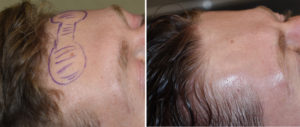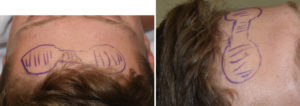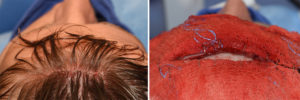Background: The shape of the frontal skull bone known as forehead is an important aesthetic facial feature. Since the forehead occupies one-third of the visible face it is not surprising that it has significant aesthetic value even though it seems like it is just a flat a amorphous structure. In reality there are very distinct gender differences in the shape of the forehead as well as having a good proportion in size to the rest of the face.
The forehead can have a variety of aesthetic deformities or disharmonies. One such aesthetic problem is the forehead that is too big or protrusive. This is most manifest as an upper forehead bulge or protrusion. Known as frontal bossing the upper forehead sticks out and can even protrude further out than the eyebrows. This is almost always due to an overgrowth of skull bone.
A unique form of a forehead protrusion is that of the forehead horns. While the term horns usually implies a pathology due to a keratinized growth from the skin, forehead horns in frontal skull surgery refers to an overgrowth of bone. This is not to be confused with an osteoma which would never present in a paired or bilateral presentation and is an outcropping of new bone growth not just part of the normal development of the skull.. These paired upper forehead bony mounds may appear like two very distinct paired protrusion or may also have a ‘dumbbell’ appearance if a ridge of bone connects between the two of them.
Case Study: This 25 year-old male presented with concerns about the appearance of his upper forehead. He had two distinct bony protrusions of his upper forehead that were particularly obvious in certain lighting due to the shadowing that it caused. There was also a small horizontal ridge of bone that connected the two more prominent outcroppings of bone.


Highlights:
1) Forehead horns are a pair of congenital upper forehead bony skull protrusions that may or may not be connected.
2) They can be satisfactorily reduced through three different incisional approaches, all work equally well.
3) Bone burring is the corrective technique for forehead horn reduction.
Dr. Barry Eppley
Indianapolis, Indiana





